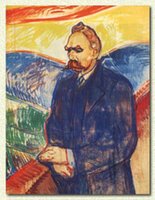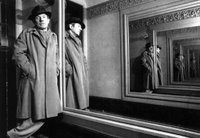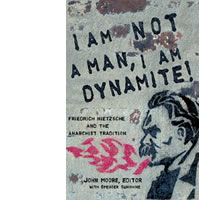Hart of Darkness, Covenant of Light
(Gaunilo's reading report for this week may be found here.) 
Hart finishes off the critical section examining postmodern thinkers with a treatment of Nietzsche, and a transitional section which introduces the constructive angle of the project, suggesting in largely philosophical terms how Christian theology can overcome (by encompassing) the bewitchments of postmodern discourse. Hart also employs a partial re-narration of Western history, not unlike MacIntyre or Milbank. (For example, MacIntyre in After Virtue renarrates modern history as the loss of classic models of virtue ethics through the concomitant loss of human teleology; Hart renarrates postmodern thought as necessarily implicating an ontology of violence, and as morally incoherent.)
Nietzsche attacks Christianity on two fronts, metaphysical and aesthetic, although Hart believes that the metaphysical is undercut fatally by Nietzsche’s other commitments, and that he was either unconcerned about being consistent, or was deploying a dialectical argument rhetorically and aesthetically. Nietzsche is important for Hart, because he believes that N is the fountainhead of the postmodern critique of Christianity – no one outdoes him or goes beyond him. In fact, Hart expresses a debt of gratitude to N for helping Christianity to remember ‘its strangeness.’ (126) Hart’s most incisive critique of N is itself aesthetic and rhetorical: Nietzsche had bad taste.
 Given N’s importance, Hart also respects Deleuze, who was closer to N, far more than Levinas, although Hart is also eager to point out that both Deleuze and Levinas (with Nietzsche) stand together on one side, ultimately all painting reality as violent and agonistic rather than peaceful and harmonic, and (ironically) reducing all difference/otherness to the same, even when trying to escape the same tendency of metaphysics. Hart – along with the uncited Milbank – affirms Christianity as the only discourse which sees being as (ultimately) peaceful and allowing otherness/difference as harmony rather than threat, when seen against a background of the infinite which is also beauty.
Given N’s importance, Hart also respects Deleuze, who was closer to N, far more than Levinas, although Hart is also eager to point out that both Deleuze and Levinas (with Nietzsche) stand together on one side, ultimately all painting reality as violent and agonistic rather than peaceful and harmonic, and (ironically) reducing all difference/otherness to the same, even when trying to escape the same tendency of metaphysics. Hart – along with the uncited Milbank – affirms Christianity as the only discourse which sees being as (ultimately) peaceful and allowing otherness/difference as harmony rather than threat, when seen against a background of the infinite which is also beauty.
Interestingly, Hart also picks up (or at least strongly echoes) a motif of Milbankian Christology (p.147) when he contends that Christ must be a shape extended through time and hence accessible in history, and able to be ‘practiced’. This renders Christ’s identity underdetermined, with a certain kind of ‘openness’; the full identity of Christ, extended through the church (and the saints especially), is only closed and revealed eschatologically. This is not to say that there is nothing to go on, or that we simply make up Christ, far from it. But it is to say that we are given a definite shape which is also underdetermined, and may be non-identically repeated.

Again, as noticed before, he does not seem to be critiquing Milbank, but generally agreeing with him: and in doing so, expanding and deepening the negative case that Milbank himself constructs. Hart’s positive or constructive case will depart from Milbank’s to some degree, of course – not least in being more well developed and (perhaps) more robustly theological. In fact, what I suspect he is doing with Milbank’s account is attempting to comprehend it, encompass it, provide a broader, more persuasive, more rhetorically-tuned account, which will take up Milbank’s and show it as one part of a larger harmony. If I am correct in this, I salute Hart for a very canny move, one which (if successful) will not only be rhetorically sophisticated, but will also participate in the beauty that it signifies. This also suggests a strategy for those who would want to critique Hart: not to cavil about this or that analytic point, but to take up the rhetorical gauntlet and run with it further than Hart wants to – that is, provide an account of God and beauty which can encompass Hart’s (and, derivatively, Milbank’s) but situate it on an even broader (or more finely detailed) canvas.
Questions and observations:
How exactly would Hart characterize what he is doing here? In the re-narrating/ counter-narrating, he shares a great deal with Milbank and MacIntyre. All three of them are clearly not modern, being strongly critical of modernity and its predations; all three of them would also deny being post-modern (inasmuch as postmodernity is identifiable, more-or-less coherently, as an intellectual movement. I have no problem with Hart’s ‘fuzzy’ definition of the movement, so long as this fuzziness is not then employed to underwrite fallacious reasoning.); all three of them draw inspiration from certain prominent pre-modern thinkers (Gregory of Nyssa (among others), Aquinas, and Aristotle, respectively), and yet they are not trying to ‘return’ to some previous time, or continue dwelling in some pure, pre-modern space. They are, in fact, post-modern in a minimalist (cataphatic?) sense, simply in terms of intentionally trying to work ‘after’ (or beyond) modernity, beyond even its relative of ‘postmodernity’. Does he consider it ‘Christian theology’ and hence something which is apart from these periodisations?
Hart speaks confidently of ‘Christian theology’ in a way which implies that it is more-or-less a coherent and agreed movement, when in fact it is somewhat more complex and multifaceted than that. While I would say that there is general agreement within Christian theology, sometimes it seems that the level of generality is so abstract as to be useless – not unlike the alleged ‘foundations’ for knowledge in philosophical foundationalism. Not much follows from the law of non-contradiction. But I digress. Is Hart stipulating that ‘Christian theology’ means not merely ‘theology done by Christians’ but some more restricted, canonical realm – say, authoritative pronouncements from the Eastern and Roman Catholic churches, and ‘canonical’ theologians for those communions, along with sympathetic others (e.g. Milbank). I mean to ask, is Christian theology suitably distant from the vagaries of (intellectual) history to be neither pre-modern nor modern nor post-modern, but to stand aside it (largely ) untouched? Hart seems to endorse the idea that Christian thinking exerted such force on neo-Platonism that it was able to re-shape it in religiously fruitful ways – an interpretation that I find both plausible and exciting. But is it also possible that neo-Platonism opened up vistas to Christian thinkers that were not previously seen or accessible? Is there lurking in the background of Hart something akin to a biblicism that would isolate a biblical or theological tradition outside the flux of time and history? Granted that modernity and later has been an arid (and even at times destructive) time for theology, are there still elements of modernity, etc., that have challenged theology and pushed it in religiously fruitful ways?
I've got other questions, but no time at present to give voice to them; maybe later this week.

Hart finishes off the critical section examining postmodern thinkers with a treatment of Nietzsche, and a transitional section which introduces the constructive angle of the project, suggesting in largely philosophical terms how Christian theology can overcome (by encompassing) the bewitchments of postmodern discourse. Hart also employs a partial re-narration of Western history, not unlike MacIntyre or Milbank. (For example, MacIntyre in After Virtue renarrates modern history as the loss of classic models of virtue ethics through the concomitant loss of human teleology; Hart renarrates postmodern thought as necessarily implicating an ontology of violence, and as morally incoherent.)
Nietzsche attacks Christianity on two fronts, metaphysical and aesthetic, although Hart believes that the metaphysical is undercut fatally by Nietzsche’s other commitments, and that he was either unconcerned about being consistent, or was deploying a dialectical argument rhetorically and aesthetically. Nietzsche is important for Hart, because he believes that N is the fountainhead of the postmodern critique of Christianity – no one outdoes him or goes beyond him. In fact, Hart expresses a debt of gratitude to N for helping Christianity to remember ‘its strangeness.’ (126) Hart’s most incisive critique of N is itself aesthetic and rhetorical: Nietzsche had bad taste.
 Given N’s importance, Hart also respects Deleuze, who was closer to N, far more than Levinas, although Hart is also eager to point out that both Deleuze and Levinas (with Nietzsche) stand together on one side, ultimately all painting reality as violent and agonistic rather than peaceful and harmonic, and (ironically) reducing all difference/otherness to the same, even when trying to escape the same tendency of metaphysics. Hart – along with the uncited Milbank – affirms Christianity as the only discourse which sees being as (ultimately) peaceful and allowing otherness/difference as harmony rather than threat, when seen against a background of the infinite which is also beauty.
Given N’s importance, Hart also respects Deleuze, who was closer to N, far more than Levinas, although Hart is also eager to point out that both Deleuze and Levinas (with Nietzsche) stand together on one side, ultimately all painting reality as violent and agonistic rather than peaceful and harmonic, and (ironically) reducing all difference/otherness to the same, even when trying to escape the same tendency of metaphysics. Hart – along with the uncited Milbank – affirms Christianity as the only discourse which sees being as (ultimately) peaceful and allowing otherness/difference as harmony rather than threat, when seen against a background of the infinite which is also beauty.Interestingly, Hart also picks up (or at least strongly echoes) a motif of Milbankian Christology (p.147) when he contends that Christ must be a shape extended through time and hence accessible in history, and able to be ‘practiced’. This renders Christ’s identity underdetermined, with a certain kind of ‘openness’; the full identity of Christ, extended through the church (and the saints especially), is only closed and revealed eschatologically. This is not to say that there is nothing to go on, or that we simply make up Christ, far from it. But it is to say that we are given a definite shape which is also underdetermined, and may be non-identically repeated.

Again, as noticed before, he does not seem to be critiquing Milbank, but generally agreeing with him: and in doing so, expanding and deepening the negative case that Milbank himself constructs. Hart’s positive or constructive case will depart from Milbank’s to some degree, of course – not least in being more well developed and (perhaps) more robustly theological. In fact, what I suspect he is doing with Milbank’s account is attempting to comprehend it, encompass it, provide a broader, more persuasive, more rhetorically-tuned account, which will take up Milbank’s and show it as one part of a larger harmony. If I am correct in this, I salute Hart for a very canny move, one which (if successful) will not only be rhetorically sophisticated, but will also participate in the beauty that it signifies. This also suggests a strategy for those who would want to critique Hart: not to cavil about this or that analytic point, but to take up the rhetorical gauntlet and run with it further than Hart wants to – that is, provide an account of God and beauty which can encompass Hart’s (and, derivatively, Milbank’s) but situate it on an even broader (or more finely detailed) canvas.
Questions and observations:
How exactly would Hart characterize what he is doing here? In the re-narrating/ counter-narrating, he shares a great deal with Milbank and MacIntyre. All three of them are clearly not modern, being strongly critical of modernity and its predations; all three of them would also deny being post-modern (inasmuch as postmodernity is identifiable, more-or-less coherently, as an intellectual movement. I have no problem with Hart’s ‘fuzzy’ definition of the movement, so long as this fuzziness is not then employed to underwrite fallacious reasoning.); all three of them draw inspiration from certain prominent pre-modern thinkers (Gregory of Nyssa (among others), Aquinas, and Aristotle, respectively), and yet they are not trying to ‘return’ to some previous time, or continue dwelling in some pure, pre-modern space. They are, in fact, post-modern in a minimalist (cataphatic?) sense, simply in terms of intentionally trying to work ‘after’ (or beyond) modernity, beyond even its relative of ‘postmodernity’. Does he consider it ‘Christian theology’ and hence something which is apart from these periodisations?
Hart speaks confidently of ‘Christian theology’ in a way which implies that it is more-or-less a coherent and agreed movement, when in fact it is somewhat more complex and multifaceted than that. While I would say that there is general agreement within Christian theology, sometimes it seems that the level of generality is so abstract as to be useless – not unlike the alleged ‘foundations’ for knowledge in philosophical foundationalism. Not much follows from the law of non-contradiction. But I digress. Is Hart stipulating that ‘Christian theology’ means not merely ‘theology done by Christians’ but some more restricted, canonical realm – say, authoritative pronouncements from the Eastern and Roman Catholic churches, and ‘canonical’ theologians for those communions, along with sympathetic others (e.g. Milbank). I mean to ask, is Christian theology suitably distant from the vagaries of (intellectual) history to be neither pre-modern nor modern nor post-modern, but to stand aside it (largely ) untouched? Hart seems to endorse the idea that Christian thinking exerted such force on neo-Platonism that it was able to re-shape it in religiously fruitful ways – an interpretation that I find both plausible and exciting. But is it also possible that neo-Platonism opened up vistas to Christian thinkers that were not previously seen or accessible? Is there lurking in the background of Hart something akin to a biblicism that would isolate a biblical or theological tradition outside the flux of time and history? Granted that modernity and later has been an arid (and even at times destructive) time for theology, are there still elements of modernity, etc., that have challenged theology and pushed it in religiously fruitful ways?
I've got other questions, but no time at present to give voice to them; maybe later this week.








1 Comments:
I think Hart has some solid criticisms of "postmodern" philosophy, but he does not make much of an improvement by adopting Radical Orthodoxy's porous Christology, a Christ who is indistinguishable from the church as the body of Christ. This is a grave error in theology, and both David Ford and John Webster are brutally harsh on R.O. supporters for their vacuous Christological models. Hart should stick to the Eastern fathers, who knew better.
Post a Comment
<< Home